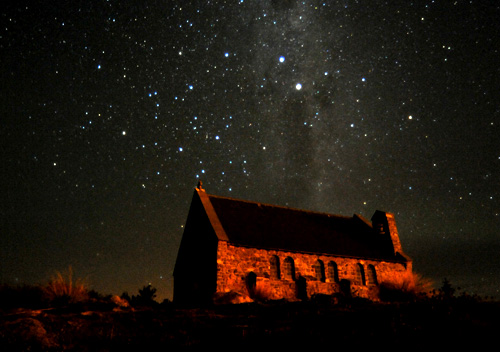
from New Zealand vol. 51 2010.05.06 Beautiful starry night sky, to whom does it belong to? ~ Questions the "Starlight Reserve" raises
![]()
- Tekapo, a village among the stars
- But the wave of development hits Tekapo as well
- Appearance of a formidable leader
- Local residents left behind
- Can they strike a balance between development and conservation of the dark starry night sky?
- The key to "the registration of a Starlight Reserve as a World Heritage Site" lies in the hands of people living in Tekapo
In New Zealand, land rich with nature, there is a village famous for its breathtakingly beautiful starry night sky. One day, a Japanese man who worked in the village as a star gazing tour guide thought of the idea to get the beautiful night sky registered as a UNESCO World Heritage Site in order to prevent "light pollution" from diluting the starlit sky. With formidable allies, this idea is beginning to take shape, but people who live in the village seem to have mixed feelings. Some are concerned about restrictions against development, some are hoping for a positive economic effect, and some are concerned about light pollution and environmental destruction. We went to the village wavering between trepidation and anticipation, and talked to the people working to get the "Starlight Reserve" registered as a World Heritage Site.
目次へ移動 Tekapo, a village among the stars
A 3-hour drive from Christchurch, the largest city on New Zealand's South Island, there is a village with a small stone church situated in front of a milky blue, glacial lake. The village of Tekapo is very small with a population of mere 300. You can look out onto the lake and the beautiful mountain range that elegantly frames the lake from the church window. This view is so mesmerizing it makes you feel at peace within. Many visitors gather from around the world to take in this view.
Tekapo has been known for this resplendent landscape with the lake and church, but there is a gentleman, who created a new image for Tekapo as a "village with a beautiful starry night sky." His name is Hideyuki Ozawa and he began working in the village as a star gazing tour guide 15 years ago.
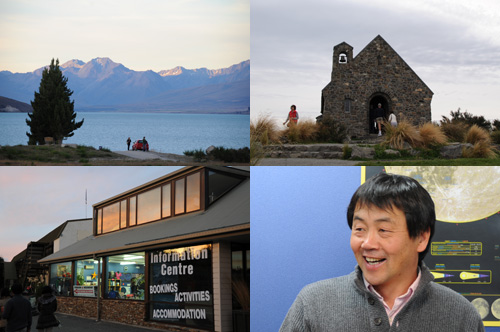 < Upper left > Tekapo, a small village with a beautiful glacial lake, means "sleeping mat" in the indigenous language of Maori. Because the water contains fine particles of rock flour created by glacial erosion, the lake shines milky white when the rays of the sun hit its surface.
< Upper right > "Church of the Good Shepherd" was built in 1935 by European pioneers. The rustic, stone structure blends in well with the surrounding nature.
< Lower left > Earth & Sky Ltd., which conducts star gazing tours, is located adjacent to the information center in the village of Tekapo.
< Lower right > Mr. Hideyuki Ozawa, who began conducting star gazing tours in Tekapo. When he first started, it was just him and his wife, but now he has 15 staff working with him.
< Upper left > Tekapo, a small village with a beautiful glacial lake, means "sleeping mat" in the indigenous language of Maori. Because the water contains fine particles of rock flour created by glacial erosion, the lake shines milky white when the rays of the sun hit its surface.
< Upper right > "Church of the Good Shepherd" was built in 1935 by European pioneers. The rustic, stone structure blends in well with the surrounding nature.
< Lower left > Earth & Sky Ltd., which conducts star gazing tours, is located adjacent to the information center in the village of Tekapo.
< Lower right > Mr. Hideyuki Ozawa, who began conducting star gazing tours in Tekapo. When he first started, it was just him and his wife, but now he has 15 staff working with him.
Tekapo is one of the best star gazing spots in New Zealand. In 1965 an observatory was built on the peak of Mt. John, a small mountain that overlooks the lake. The Mount John Observatory is the southern-most observatory in the world.
There are many stars and constellations we can't see from the northern hemisphere, the most famous of which is the Southern Cross. Depending on the time of year, the Milky Way stretches across overhead, so even if you aren't an astronomy fan, you can't help but look up and admire the stars. What's more, it is sunny many days of the year, dry, and the air is clear, and because there are no large cities nearby, there are hardly any city lights. The beautiful starry night here at Tekapo is accessible to everyone because you don't have to climb thousands of meters to gaze at stars.
Japanese astronomers have a base here as well. There are 5 telescopes on Mt. John, and New Zealand's largest telescope - the MOA-II - is operated by the Nagoya University. They are looking for planets outside the solar system and dark matter, focusing especially on the "center of the galaxy" and the Magellanic Clouds.
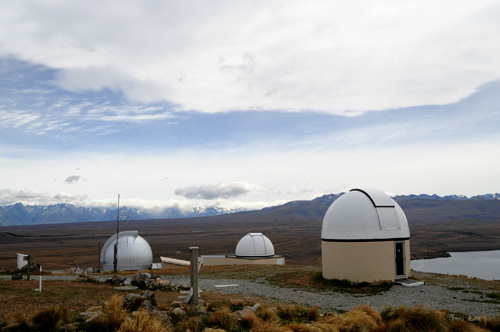 The peak of Mt. John (altitude: 1030m) during the day where you can find domed telescopes. Tekapo is located at an altitude of 710m, so you only have to climb a few hundred meters to reach the peak.
The peak of Mt. John (altitude: 1030m) during the day where you can find domed telescopes. Tekapo is located at an altitude of 710m, so you only have to climb a few hundred meters to reach the peak.
With Mr. Ozawa's tour, you make your way towards the mountaintop on a bus after sundown. After the veil of darkness descends, the bus heads towards the peak without any headlights. This is because headlights get in the way of star gazing. Once you reach the peak and get off the bus, you are asked to tilt your face towards the sky while keeping your eyes closed. When you finally open your eyes you are immediately swept off your feet by the breathtakingly beautiful, starlit sky. It doesn't feel like you're looking up at the stars. It is as though you have been suddenly thrown into space amidst the stars.
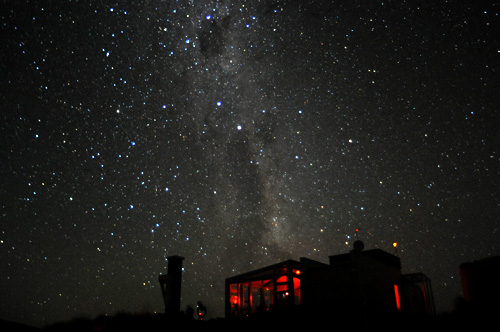 Mt. John's peak at night. The Southern Cross shines bright with the Milky Way in the background. You can also lie down on the floor of this building and gaze up at the stars.
Mt. John's peak at night. The Southern Cross shines bright with the Milky Way in the background. You can also lie down on the floor of this building and gaze up at the stars.
As we were gazing at the stars, Mr. Ozawa said:
"When I gaze at the stars, I feel like I am bathing in the forest, absorbing the alpha waves."
Here, it's like bathing in the stars. This is an experience unique to Tekapo, where you can immerse yourself in starlight.
Although many places may be renowned for star gazing, and these places may be located far away from large cities, you can often still see the lights of large cities shining in the distant horizon. In Tekapo, stars shine bright all the way down to the horizon. When you're up on the mountain peak looking up at the stars, you get a false feeling that the stars continue endlessly, all around you, even beneath your line of sight.
But for people who live here the starry night sky is quite commonplace; it is as commonplace as the air around us. They took it for granted and did not realize that the starlit sky they enjoy every night is a very rare sight.
"What? A business based on showing people stars...?" When Mr. Ozawa began his star gazing tour, even the local newspaper poked fun at him. But gradually its reputation spread across the country and around the world, so that now there are increasingly more people especially from within New Zealand that come to experience the star gazing tour.
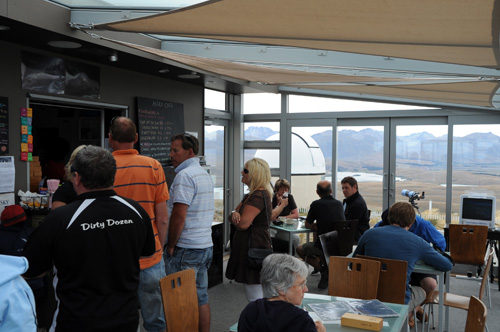 The Astro Café found at the peak of Mt. John. Many people come from all around the world to "experience the stars in Tekapo."
The Astro Café found at the peak of Mt. John. Many people come from all around the world to "experience the stars in Tekapo."
目次へ移動 But the wave of development hits Tekapo as well
Around the year 2000, the development bubble hit New Zealand. This wave rolled in on Tekapo as well, and plans to significantly expand the commercial district,, which used to be a dozen or so buildings, and residential district were drafted. This would ruin the dark starry night in Tekapo - Mr. Ozawa, who had grown up in Japan, could clearly see where this was headed.
In Japan, and in many parts of the world, many cities have and are losing the beautiful nature and unique landscape during the process of development. And Tekapo was about to head down the same path. Mr. Ozawa became quite concerned about the future of Tekapo.
Having said that, because Tekapo has been home to an observatory from long ago, it is not as though the people here had been complacent about "light pollution" that dilute the starry night. The local council had begun regulating lights a few decades ago. Now, even the street lamps have umbrellas to prevent light from spilling over, and the village uses low pressure sodium light bulbs that have less impact on star gazing. However, there are no regulations against lighting for commercial facilities, so should the business district continue to expand, the night sky will certainly become diffused with white, hazy light.
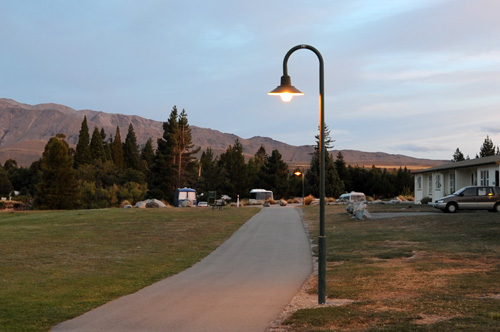 The street lamps use low pressure sodium light bulbs with umbrellas on top to help keep light spill over to the minimum.
The street lamps use low pressure sodium light bulbs with umbrellas on top to help keep light spill over to the minimum.
Vehicle headlights had long been a problem. Headlights 10km away reach Mt. John's peak. The high beams of cars heading towards the mountain peak cast a clear shadow on the observatory dome walls when they turn towards the direction of the peak.When such lights hit your eyes you can't see the stars very well, even if they are shining bright above your head.
Should development be carried out apace with the momentum of the bubble, the business and residential district expand, and number of cars traveling on the roads increase, the starry night sky will be lost. Is there something that can be done to prevent this from happening? One day, Mr. Ozawa thought of an idea.
"Let's try to get Tekapo's starry night registered as a World Heritage Site."
A "starry night sky" has never been registered as an UNESCO World Heritage Site. So it seemed, at the time, a gargantuan task.
But Mr. Graeme Murray, Mr. Ozawa's partner at Earth & Sky Ltd., was very moved by Mr. Ozawa's desire to "protect the beautiful night sky."
"Those of us who grew up in the village used to take the starry night sky foiled by the pitch darkness for granted. We never thought that it could be something that could be lost. When Hide told me, I realized how precious our starry night really was. That it was indeed a heritage that we should bequeath to the next generation. Moreover, being registered as a World Heritage Site will certainly contribute to "Astro Tourism" we are trying to promote, which fuses together the science of astronomy and tourism."
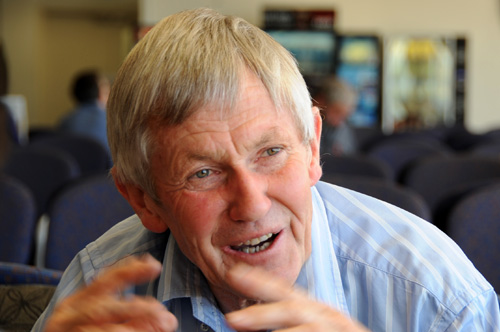 Mr. Graeme Murray, Mr. Ozawa's partner at Earth & Sky Ltd.
Mr. Graeme Murray, Mr. Ozawa's partner at Earth & Sky Ltd.
目次へ移動 Appearance of a formidable leader
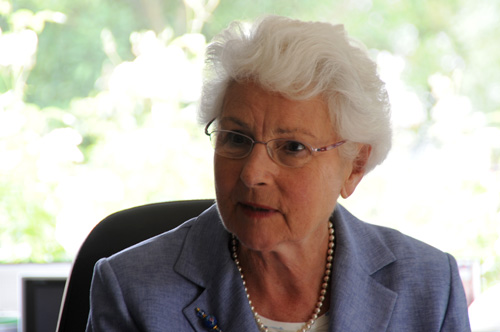 Ms. Margaret Austin, former Labour cabinet minister of New Zealand.
Ms. Margaret Austin, former Labour cabinet minister of New Zealand.
Mr. Murray then asked Ms. Margaret Austin, who has long been involved with UNESCO, for her assistance on this matter.
Ms. Austin was once appointed New Zealand's Minister of Research, Science and Technology. If Tekapo is registered as the world's first "Starlight Reserve," it may help encourage interest in astronomy as well as science in general among people not only in New Zealand, but also all around the world, especially children. This hope helped convince Ms. Austin to take on a leading role in promoting this movement.
"New Zealand was discovered by the Maori who arrived here on a boat from Polynesia.For the Maori, stars are extremely important; at sea, they help them navigate and on land, they serve as a calendar and show the Maori when it is time to harvest. The first white man who arrived in New Zealand, Capitan James Cook, also was lead here by the stars. Stars, which have helped build our nation, are a great legacy for the people of New Zealand."
Actually, in 2005 when Ms. Austin heard about this movement, discussions on the inclusion of astronomy in the World Heritage provisions were also taking place in the UNESCO's headquarters located in Paris.
Although the "Convention Concerning the Protection of the World Cultural and Natural Heritage" states that sites with outstanding universal "historical," "artistic," "conservational" and "scientific" value be listed as World Heritage Sites, no sites have been recognized as being a World Heritage Site with outstanding universal scientific value thus far.
Astronomy is one of the oldest sciences that mankind has been studying. Perhaps discussions on the registration of astronomical monuments, sites, and landscapes as World Heritage Sites are a natural transition.
Pursuant to various discussions, 5 sites around the world including Tekapo and the Mauna Kea Volcano in Hawaii were nominated as candidates for the pilot study regarding the registration of starlit skies as World Heritage Sites. In the end, Tekapo and nearby Aoraki/Mt. Cook was selected as the final candidate. Currently, Tekapo is closest to obtaining the World Heritage status.
目次へ移動 Local residents left behind
Tekapo's acquisition of the World Heritage status has become a real possibility with the involvement and leadership of Ms. Austin, who plays a key role in UNESCO and in New Zealand. However, people of Tekapo have begun to have concerns regarding this matter.
Mr. Andrew Simpson, a sheep farmer who owns a vast stretch of land in and around Tekapo, said:
"Although such a big movement to register Tekapo as a World Heritage Site was moving forward on a global level, residents had not been informed about it at all. Many people here are concerned that if things proceed as is, one day strangers may come and impose strict regulations on the villagers, and we wouldn't be able to choose our own destiny. For example, it would be a big problem for us if restrictions prohibiting development are implemented."
When I asked if he meant economic development by this he replied:
"I mean in every aspect, including economic growth, streamlining various social functions and frameworks for environmental conservation. There is no doubt that the starlit sky of Tekapo is wonderful. But, if we are told that 'the starry night sky takes precedence over everything, and everything else has to be sacrificed,' as residents, we can't just sit on the sidelines and do nothing."
 < Left > Mr. Andrew Simpson who owns a vast plot of land including a 9,700-hectare farm.
< Left > Mr. Andrew Simpson who owns a vast plot of land including a 9,700-hectare farm.
< Right > Mr. Karl Burtchur, a local businessman.
Mr. Karl Burtchur, who operates various recreational facilities such as hot pools, spa, and ice skating rink, also expressed his concern.
"Because I run recreational facilities, it is not as if I'm not hoping for benefits that may result from Tekapo being registered as a World Heritage Site. Even still, I'm much more concerned about the lives and businesses of the local residents. For example, it would be seriously damaging to our business if we have to dim the lights of the ice skating rink at night. It won't be just my business that will be affected. Depending on the restrictions set by UNESCO, we would be bound hand and foot, and Tekapo wouldn't work."
So, how does the local government feel about this? Mr. John O'neill, Mayor of the Mackenzie District Council, which includes Tekapo, shared his thoughts:
"We have been taking measures to protect Tekapo's starry night sky by, for example, implementing the lighting ordinance, but at the same time, it is also important to help improve the lives of the local residents, which includes rights to undertake development."
The Starlight Reserve Committee has been organized to promote Tekapo's registration as a World Heritage Site. Mayor O'neill thought it was necessary to have a person who can represent the local residents in the committee, so Mr. Simpson was recently welcomed as a member of the committee. The dialogue between the local residents and the committee is finally about to begin.
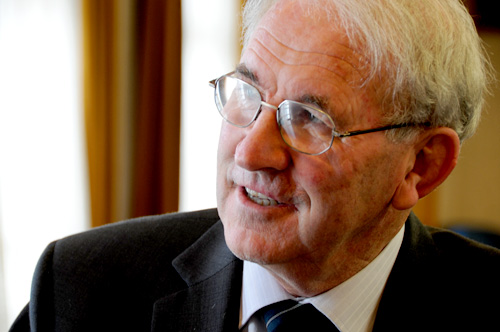 Mayor John O'neill of the Mackenzie District Council.
Mayor John O'neill of the Mackenzie District Council.
目次へ移動 Can they strike a balance between development and conservation of the dark starry night sky?
The observatory was built here in Tekapo because the astronomer, Mr. Alan Gilmore determined that it was the best location for star gazing pursuant to surveys of various regions in New Zealand at the behest of the University of Pennsylvania. Mr. Gilmore, who has been gazing at the stars in the village of Tekapo ever since the observatory was built, said:
"The village of Tekapo has grown to 3 times the size of what is used to be when I first came here. However, this doesn't mean that the stars have become 3 times harder to see. Even if Tekapo becomes a World Heritage Site and the urban district becomes larger, we can prevent light pollution by employing better lighting methods and with technological advancement."
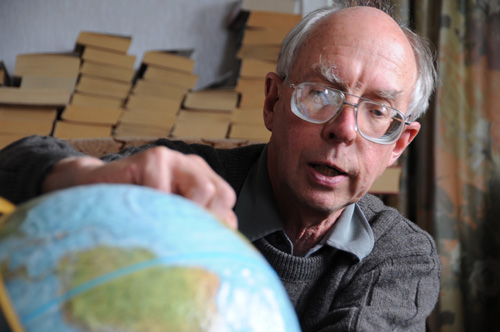 Mr. Alan Gilmore, resident superintendent of the Mount John Observatory.
Mr. Alan Gilmore, resident superintendent of the Mount John Observatory.
Mr. Gilmore also pointed out that large cities around the world are filled with street lamps that needlessly light up the surrounding area and do not effectively light up the desired area (e.g. roads).
"Such lighting just wastes energy. And it makes it harder to see the stars at night. Not only do light bulbs have umbrellas new lighting such as sodium light bulbs is being developed. I'm sure such technology will continue to evolve."
Both Ms. Austin and Mr. Murray said that Tekapo's registration as a World Heritage Site does not necessarily mean that all forms of development have to be prohibited and people's lives have to be bound by rules. Although unchecked development would be restricted, because Tekapo has a history and proven record of controlling lighting, even if some development takes places, people of Tekapo will be able to design a starry night sky conscious town.
Mr. Takahiro Sumi, a researcher at the Nagoya University who has been observing the stars with the MOA telescope said, "The registration as a World Heritage Site may bring about an even darker night sky."
"It is true that the starlit sky has become gradually lighter compared to 10 years ago when I started coming to Tekapo and it is starting to affect our observation activities. Preservation of the dark, starlit sky would be a prerequisite for the starlight reserve's registration as a World Heritage Site, so I hope that any future development will take the conservation of the starlit sky into consideration, for example, the lighting regulation currently only applies to street lamps, but I hope this will also be applied to commercial facilities."
 < Left > Mr. Takahiro Sumi of Solar-Terrestrial Environment Laboratory, Nagoya University.
< Left > Mr. Takahiro Sumi of Solar-Terrestrial Environment Laboratory, Nagoya University.
< Right > New Zealand's largest telescope with a diameter of 1.8m. You can shoot images of the starlit sky by connecting a large CCD camera to the telescope.
On the other hand, Mr. Ozawa is quite seriously concerned about development.
"Tekapo's registration as a World Heritage Site will be good for my business. Even still, I'm very worried that once Tekapo is registered as a World Heritage Site this area would undergo excessive development, making the starlit sky brighter and destroying nature. Depending on the situation, it may be better to withdraw our application to the World Heritage Site."
What he proposed in order to stop development may have quite the opposite effect and bring on even greater development. Perhaps Mr. Ozawa feels deeply responsible about the situation since he was the one who came up with the idea.
目次へ移動 The key to "the registration of a Starlight Reserve as a World Heritage Site" lies in the hands of people living in Tekapo
Mr. Ozawa constantly asks himself "what good will the registration of Tekapo as a World Heritage Site do to local people who live here quietly."
"It's easy for people from the outside to come in and ban lighting for ski slopes and ice skating rinks, but ice skating has been an intricate part of people's lives here in Tekapo since long ago. And street lamps that light up the dark streets at night are important for ensuring people's safety. I don't think it's right to reject the village's cultural heritage and one-sidedly demand that villagers sacrifice their lives to protect the starry night sky. I'd like to talk to each and every villager and hear about their feelings towards registration as a World Heritage Site."
Enchanted by Tekapo's beautiful nature, Ms. Debra Hunter moved here 6 years ago and she now runs a café that serves organic coffee. Ms. Hunter said:
"I'm in favor of Tekapo becoming a World Heritage Site. But I think we should find the answer to striking a balance between protecting the starlit sky and our lives, lifestyles ourselves. It would be best if we can take pride in the fact that 'we are helping to preserve the starry night sky,' rather than being ordered by someone else to do so."
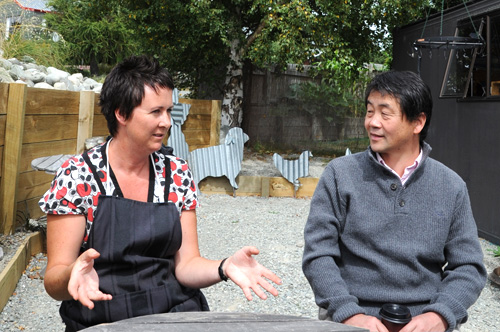 Mr. Ozawa asks Ms. Debra Hunter, who runs a café, how she feels. Mr. Ozawa is not taking any shortcuts; he is meeting with many villagers in search of clues that will lead the way to the best solution.
Mr. Ozawa asks Ms. Debra Hunter, who runs a café, how she feels. Mr. Ozawa is not taking any shortcuts; he is meeting with many villagers in search of clues that will lead the way to the best solution.
It is also my hope that the World Heritage Sites not only preserve the landscape, nature, and townscape exactly as it appears in a still photograph,but that they also pay due attention to the lives of the people who live in those areas. Heritage that does not embrace the people - for whom is it for?
Having said that, if Tekapo's starlit sky becomes recognized as a World Heritage Site, restrictions applied by UNESCO will provide a huge umbrella framework for protecting the starlit sky, and we can hope for development involving unprecedented new ideas that takes light control and environmental conservation into consideration. On the other hand, Mr. Ozawa's concerns may be justified and the starry night sky may be lost due to development that may take place with the expected World Heritage Site registration.
So, what path will Tekapo decide to take? Although we received varying feedback from the people we met during our visit, the common denominator was their appreciation for the beautiful nature of Tekapo and the local community. I have returned to Japan, but I am looking forward to seeing what path the people of Tekapo will choose. It is my hope that the registration of Tekapo as a World Heritage Site will not be something that is decided by the authorities, rather, that it will be decided by the local residents who will continue to cherish and protect Tekapo's beautiful starry night sky.
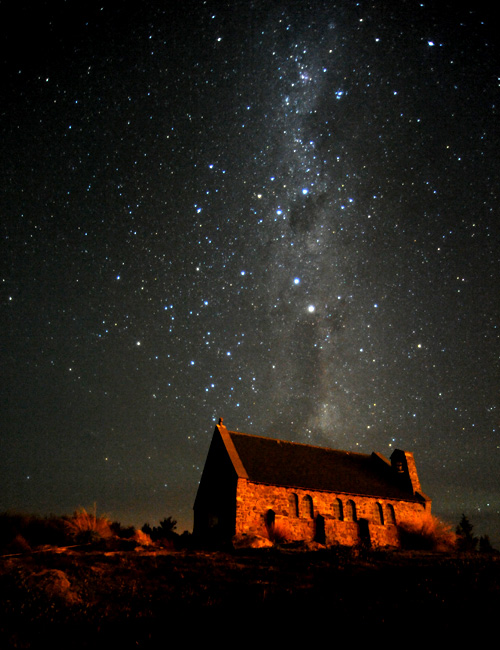 The Milky Way and the Southern Cross disappearing behind the "Church of the Good Shepherd" on the edge of the Tekapo lake.
The Milky Way and the Southern Cross disappearing behind the "Church of the Good Shepherd" on the edge of the Tekapo lake.
Eri Eguchi Biography
Born in 1973. She became a freelance editor and writer after working at Hankyu Communications Co., Ltd. (former TBS-BRITANNICA Co., Ltd.) and at the UK-based Bloomsbury Publishing Plc. as an intern. Author of "Bonobo - The Most Human-like Apes on Earth" and "The Meerkat Family" (published by Soensha Co., Ltd.).
Reported and orginal Japanese text written by: Eri Eguchi
Translated by: Yuri Morikawa (oxygen inc.)
Photographs by: Soichi Ueda (Think the Earth Project)
Cooperation from: Hideyuki Ozawa (Earth & Sky Ltd.)















